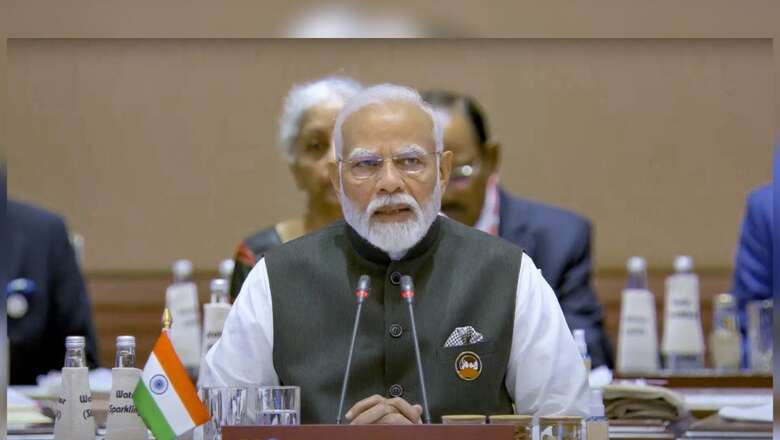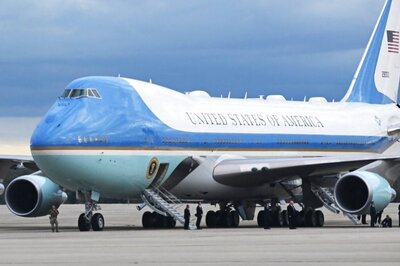
views
In a serendipitous exhortation on September 3, RSS Chief Mohan Bhagwat, in an epiphanic elucidation, entreated the citizenry, advocating for the nomenclature ‘Bharat’ as opposed to the anglicised ‘India’. He emphasised, “The name of the country, Bharat, will remain Bharat wherever you go in the world.” Just two days after this proclamation, an invitation from the ‘President of Bharat’ took social media by storm, setting off a whirlwind of political dialectic. This sudden move sparked speculation in the political corridor about a potential renaming of the nation, especially against the backdrop of the G20 summit. The ensuing controversy saw the BJP and the fragmented Opposition trading blows. The I.N.D.I.A. alliance countered by pressing that the BJP government is considering renaming the nation simply because of their alliance name.
Revisiting the nomenclature in the Constitution
The Constitution of India, uniquely imbued with both ‘India’ and ‘Bharat’ in its commencement, serves as a testament to the nation’s history and identity. This duality wasn’t merely a whim but a culmination of fervent constituent assembly debates, tracing back to November 17, 1948, which sought to crystallise the nation’s appellation. The Constituent Assembly resonated with voices championing the name’s indigenous essence. Hari Vishnu Kamath and Hargovind Pant stood out, advocating for ‘Bharat’ and highlighting the lingering colonial connotations of ‘India’. Pant, in particular, emphasised the genuine aspiration of the people for an identity untarnished by foreign imposition. As Dr. B.R. Ambedkar astutely summarised, the contention wasn’t against ‘Bharat’ but its juxtaposition with ‘India’. Through these deliberations, the dichotomy of Bharat and India emerged—the former was rooted in the illustrious annals of Puranic literature and the epics of Ramayana and Mahabharata, while the latter was reminiscent of our colonial past. The Puranas portrayed Bharata as a vast realm stretching between the southern seas and the northern snowy peaks. Catherine Clémentin-Ojha articulated ‘Bharata’ as more than just geographical territory; it epitomised a socio-cultural entity. The name echoed through history, from the legend of King Bharata, the progenitor of the Rig Vedic Bharatas, to Nehru’s writings emphasising the timeless unity of ‘Bharata’. Yet, as time progressed, the Mughal dynasty adopted ‘Hindustan’ to represent the Indo-Gangetic plains, and by the late 18th century, the term ‘India’, aided by colonial influences, began to overshadow ‘Hindustan’. Historian Ia J. Barrow argued that this shift encapsulated a changing perspective on the subcontinent’s identity.
As a nation-state reborn in 1947, we surged forward with vigour but faced a palpable void—a lack of a unifying language, which inadvertently weakened our connection to our storied past. In this light, it is not just a matter of pride but a duty of a self-respecting society to reinstate names like Bharat, reconnecting us with our heritage and strengthening our national identity. The transition from Bharat to India is emblematic of the nation’s multi-faceted identity, interwoven with its colonial legacy and its endeavour towards an indigenous renaissance.
The Dharmic rubric of Bharat is the essence of our civilisation and culture. That we are outwardly looking, non-aggressive, progressive, pluralistic, tolerant, responsible, and democratic has been inveterately ingrained in our DNA since time immemorial. The roots of democracy can be traced as early as the 4th century. The stone inscriptions of Thanjavur are a living testimonial of the same. As former Union Minister, the late Anil Madhav Dave, noted in his seminal work, ‘Shivaji and Suraj’, “in the midst of our national evolution, there emerges a pressing dialogue about embracing our ancestral roots, symbolised powerfully in the name Bharat.” He further goes on to say, “There are some in our progressive society who may question the merit of reverting to ancient names for places and cities. However, one cannot overlook the profound wisdom embedded in our traditional linguistic science, which posits that a name, composed of specific syllables, is not just an identifier but a reflection of the Supreme One.”
PM Modi’s Crusade Against Colonial Vestiges
From its inception, the Modi administration has been assiduously labouring to purge what they term the “relics of British dominion” and emancipate the nation from its “colonial baggage”. The venerated PM Modi accentuated this trajectory by heralding decolonisation as a cardinal tenet of the ‘Panchpraan’ from the ramparts of the Red Fort on August 15, 2022. Aligned with this ethos, the state embarked on a series of nomenclatural metamorphoses. These efforts also include renaming roads and buildings related to both India’s Mughal and colonial pasts. A case in point is the 2022 appellation overhaul of Rajpath, erstwhile Kingsway, to Kartavya Path. A similar transmogrification was witnessed in 2018 in the Andaman and Nicobar archipelago, wherein three Indian islands named after British rulers were renamed “to erase the sign of slavery”. Also, the cartographic representation of “Akhand Bharat’” in the nascent parliamentary edifice is emblematic of these exertions.
The use of Bharat on the G20 invites didn’t go unnoticed and has raised eyebrows among Opposition leaders. However, the Modi government’s track record has demonstrated a blend of modern pragmatism and cultural heritage. Initiatives like Ayushman Bharat, Swachh Bharat Mission, and Atmanirbhar Bharat Abhiyaan have witnessed unprecedented success, while Modi named his top-of-the-breed initiatives Start-up India and Make in India, thereby displaying pragmatism when dealing with non-Indian stakeholders from time to time. It’s puzzling why the Opposition overlooks the nation’s legacy.
The enigma persists as to the Opposition’s myopia towards our national patrimony. Article 1 of the Constitution clarifies “India is Bharat.” Moreover, former PM Jawaharlal Nehru, despite conventional norms, awarded himself the title of ‘Bharat Ratna’. The Congress has often championed Nehru for the inception of PSUs like BHEL (Bharat Heavy Electricals Limited) and Bharat Petroleum. More recently, a commune—that now flaks the purported change, which is not even official yet—while expressing scorn for the name Bharat, was busy then tomtoming about the “Bharat Jodo Yatra”. If they harbour reservations about the name Bharat, their choices seem incongruous. Even a cursory Google search of ‘Bharatiya Reserve Bank’ points towards the RBI. Further, one must ponder if the I.N.D.I.A. alliance endorses “Bharat Bhagya Vidhata” in our national anthem or not! An archaic verse from the sacrosanct Vishnu Purana encapsulates the sentiment:
उत्तरं यत् समुद्रस्य हिमाद्रेश्चैव दक्षिणम् | वर्षं तद् भारतं नाम भारती यत्र सन्ततिः ||
This translates to, “The country that lies north of the oceans and south of the snowy mountains is called Bhárata, for there dwell the descendants of Bharata. Bhárata is the land of works, in consequence of which men go to heaven or obtain emancipation.”
Final Reflections
- The renaming of the topic prompts a question: Why did the UPA decide to rebrand as the I.N.D.I.A alliance if renaming is so unnecessary in the first place? Perhaps we must explore the reason behind the fact that a Britisher named A. O. Hume founded the Indian National Congress while India wasn’t a free nation.
- Does the Indian National Congress not agree with our nation’s heritage, or are they just opposing the ruling party regardless of the issue, like in the past? Well, the discussion doesn’t seem limited to the Indian National Congress vs. the Bharatiya Janata Party.
- Should a nation with a millennia-spanning history adhere to a name designated by foreigners, or should it seek to embrace and reclaim its ancient glory? As V.S. Naipaul delineated the issue, India is a wounded civilisation, and Bharat, as they say and document, has been the golden bird, contributing a third of the world’s economy from 3000 BCE to around the 10th century AD. India came into existence after the British, but Bharat has been here since time immemorial and will be here till the end of eternity.
Yuvraj Pokharna is an independent journalist and columnist. He tweets with @iyuvrajpokharna. Views expressed in the above piece are personal and solely that of the author. They do not necessarily reflect News18’s views.




















Comments
0 comment